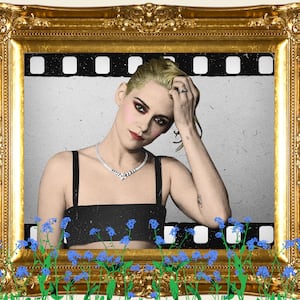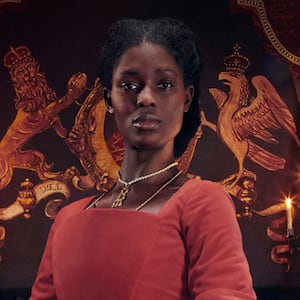It should seem implausible that there would be anything new to say about the story of Princess Diana. What piece of pop culture, at this point, could possibly add anything to our understanding and our emotion about her supernova existence in the public eye and her tragic death?
These last years especially have seen her life and the impact of her death parsed and chronicled in an endless torrent of new documentaries, each promising some tantalizing new detail or anecdote to entice insatiable consumers of all things Lady Di. It’s also been fictionalized, dramatized according to rumor and assumption in high-profile projects like The Crown and the recent Kristen Stewart-starrer Spencer.
Is it a bad thing that there seems to be an infinite appetite for this content, and ample offerings produced to answer the call? There is so much to learn about the media, the monarchy, and ourselves, let alone about one of the most famous women there has ever been, so why shouldn’t there be so much content? Then again, it was the ravenous and rapacious demand for her story, for her image, and for her secrets that did so much harm to her mental health, and then ultimately was responsible for the violent car crash that ended her life. What is this demand for more, if not a cycle repeating?
That’s a salient point gleaned from the stunning new documentary The Princess, which premiered Thursday night as the opening film of the 2022 Sundance Film Festival. Those questions—what else is there to say, and how else could it possibly be said?—have already been asked an incalculable number of times. Maybe the questions should instead evolve. How have we been shaped by these events? And how have we remained obstinately ignorant in spite of them?
Directed by Ed Perkins, The Princess begins with immediate unease. There is shaky camera footage being filmed from inside a car as it tours the streets of Paris, France, where the fateful crash occurred. As the car approaches a melee of gawkers, photographers, and camera flashes, the person holding the camcorder gets excited by the commotion. Suddenly the paparazzi in the crowd jump in their cars and start peeling away, chasing the famous figure who had caused such a stir. The civilian chirps excitedly: “It’s Princess Diana!”
The documentary is a depiction of Diana’s life from nearly the moment she became the fascination of the public and the media, told through their lens: the camera. Amid a glut of Diana content, what we’re seeing here is, as the handheld footage from a tourist in Paris hinted at, a surprising shift in perspective.
The Princess uses only archival footage that was filmed at the time the events of Diana’s tumultuous life took place. The goal, as a Sundance Fest press summary says, “is turning the camera back on ourselves” and illuminating “the profound impact she had and how the public’s attitude to the monarchy was, and still is, shaped by these events.”
It’s less what’s going on behind closed doors, beyond the palace walls, or inside the relationship we could never know the real truth about, but what there was and is to learn from what was happening in plain sight. What does this footage say about who she was and how this attention, let alone her tortured time within the royal family, affected her? What does it say about the monarchy and how it did and didn’t protect her? And what does it say about not just the media, but also us, the voracious consumers of all things Diana… even now, all these decades later?
There’s an illusion that comes with this kind of clear-eyed approach, an assuredness that, because the film relies on old news and archival footage, we’re not watching hearsay. It feels less tawdry or ghoulish, and, because of that, even more emotional. That’s powerful. Segments focusing on how she was talked about and treated by the press are more horrifying; ones that center on the palace’s cruelty toward her, essentially leading her out to slaughter, are more infuriating; and the chronicling of the end of her life is all the more devastating.
It’s crucial to remember, however, that this could also be sleight of hand. Yes, it’s archival footage, but there is still a narrative pieced together. We don’t know how the clips and the commentary were chosen—let alone from what outlets that may or may not harbor a certain bias—and if that played a part in telling a certain story. Nonetheless, there’s no denying that this is a refreshing, heartrending, and, in the end, haunting approach to telling this story, just when it seemed every avenue had already been exhausted.
Even with all we know about Diana, there are revelations to be had in watching things unfold in this manner.
We see her, after that Paris-set opening, years earlier, when her engagement to Charles was first announced. She’s walking down the street, being followed by throngs of people running up to her asking when the wedding is happening. She’s giggly and nice, but shy, as she talks to them. It’s making her obviously uncomfortable. She’s bashful. She keeps saying there’s no comment. It’s quite the rewind from that opening scene. Especially after setting up the film with the foreshadow of the darkness to come, it’s eye-opening to see her so pure and still unscathed.
Of course, that attention quickly escalates. From the beginning, even before the wedding takes place, there are pundits who raise the question of whether the press needs to lay off her.
The scrutiny that was placed on her came at an evolutionary point for the press and news media. To be made aware that this conversation was present from the start of that transformation was jarring. Even then, there was enough awareness to ask those questions and make those points; to wonder openly about whether this was fair or even harmful to a person. Yet there was still the entitlement to take her privacy from her—as well as her image, her time, and her existence.
Still, there’s a joyfulness to the start of it all. As footage of people watching the wedding on TV, camped outside the palace celebrating in union jack garb, and obsessing over every detail of her styling plays, a newsreader speaks, almost drowned out by the spliced-in audio of shrieking crowds as the marital carriage zooms by: “It’s the stuff of which fairy tales are made. The prince and princess on their wedding day. But fairy tales usually end at this point, with the simple phrase of ‘they lived happily after.’ Our faith sees the wedding day not at the place of arrival, but the place where the adventure will begin.”
With similar briskness, The Princess illustrates the contrast between the public enthusiasm for this fairy tale and the royal family’s indifference, which would eventually metastasize, at least in this film’s narrative, to maliciousness. Londoners are shown popping champagne after learning the news of Diana’s first pregnancy. Compare that to the reaction of the Queen and Princess Anne, who basically shrug at the news, feigning that they had no idea. (Meanwhile grocery stores were announcing it over their loudspeakers as patrons shopped.)
One thing that is unignorable in the documentary is how charming and captivating Diana was. You fall in love with her again, as you always do when you see even a glimpse of the footage of her, for example, interacting with hospital patients and, as so many broadcasters say, “ordinary people.” The charisma packaged in a 106-minute film is more irresistible than ever.

Prince William and Prince Harry look at a statue they commissioned of their mother Diana, Princess of Wales, in the Sunken Garden at Kensington Palace, on what would have been her 60th birthday on July 1, 2021, in London, England.
Dominic Lipinski/GettyAs damaging as we now know all that fanfare, hysteria, and demand for attention was, it is genuinely moving to see how earnestly and enthusiastically people gravitated toward her and adored her—not to mention how warm and intimate she managed to make those interactions in return. It was an electric connection between that “ordinary” and the extraordinary, a leveling charge between the superstar and the citizen, that was singular. It hasn’t happened before or since.
The remarkable nature of Diana’s life, at least as it unfolded publicly in this film, is how drastic the contrast is between those high points of her character and the low points of her experience with Charles, let alone how that was gnawed at by the press.
To see the unedited footage of the couple while they were rumored to have discord play on screen while audio of the commentators viciously picking apart every gesture and making assumptions of what that must mean, sure, tells its own narrative about their purported unhappiness. But it’s simultaneously a searing indictment of the media and its self-appointed right to cast such judgments and aspersions, a license that hasn’t expired in the time that’s passed since—no matter how many examples there have been illustrating its toxicity and harm.
It’s grotesque to hear again how rumors of her suicide attempts, her mothering, her depression, her eating disorder, and her and Charles’ affairs were discussed, typically from strangers who spoke as though they were authorities on the manner, as if these secrets and whispers were the gospel truth. Yet it’s also so familiar to anyone who consumes—or is a part of—media today.
Things get sinister. You see Diana become desperate in her interactions with the paparazzi. That coy warmness and excitement turns combative. The cameras and reporters are increasingly lecherous. It’s disturbing.
Here’s a sampling of the reaction to a statement she made about stepping back from obligatory duties because of this: “It’s very Diana isn’t it, to call a press conference to say she wants to be left alone?” “I bet you she’ll be back. She’ll do a song and dance act to be back on the front pages.” “I think she’s close to being a monster.”
The reflexive smugness, dismissal, and bad-faith reading of any action: Once again, it’s hard to hear, and once again it is familiar. Who’s to say if this is the international phenomenon that planted the seed of that imposing tree that has continued to expand its roots to the present day, where trolling, attacks, and vitriol are the normalized reaction to any person in the public eye—especially when a plea is made for empathy.
It’s inspiring to once again revisit Diana’s focus on her charity work after that and how committed she was to it, but there’s also commentary about the adoration she got from it. Was it for her ego, or a tool, as the spotlight brought awareness and opportunity? Or, maybe, both?
It doesn’t need to be said just how emotional the end of the film is, though there is a bluntness to the conclusion that leaves you in those thoughts about complicity, about exploitation, about the monarchy, the press, and our own selves.
You don’t leave The Princess with a brand new viewpoint, per se. Diana comes off well, while the palace and the media are villainized, as is the common and accepted modern take on what happened during that time.
But to reconsider all of that through how we consumed it and, not only that, how we were fed it, is a fascinating exercise—even if it’s one made possible by the excessive lenses and attention that were placed on her that we now feel we should condemn… but maybe never will.








